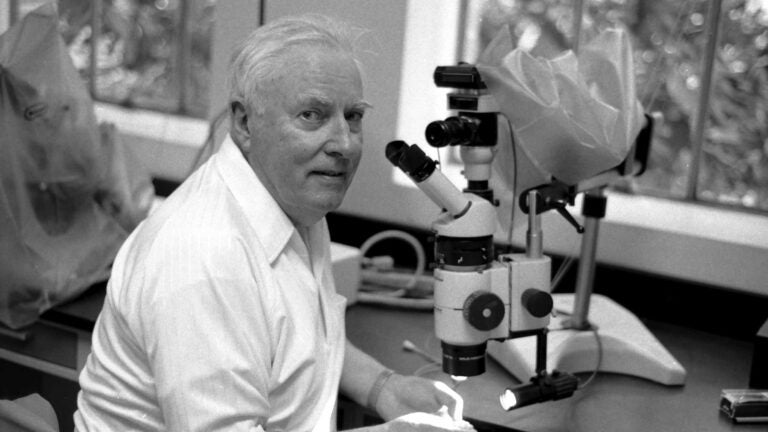
In memoriam: Alfred Fischer, 96, prominent geologist
Professor emeritus became a world leader in sedimentary geology and a devoted teacher whose 1952 book on paleontology endured for more than six decades
Professor Emeritus of Earth Sciences Alfred “Al” Fischer, a globally prominent geologist, has died. He was 96.
Fischer died July 2 at Maravilla Senior Living Community in Santa Barbara.
Fischer made major contributions to the understanding of environmental cyclicity, characterized by repetitive patterns of different rock layers, or strata, in the Earth.
“Al Fischer was one of the most globally prominent sedimentary geologists of the second half of the 20th century,” said David Bottjer, professor of Earth sciences, biological sciences and environmental studies at the USC Dornsife College of Letters, Arts and Sciences. “At USC he was a wonderful colleague who sparked many innovative research interactions at the intersection of Earth and life evolution, and was the prototype faculty member for our department’s now leading program in geobiology.”
The breadth of Al’s influence spans generations and is global. The Earth sciences community has lost an icon.
William Berelson
Describing Fischer as a renaissance scholar, William Berelson, professor of Earth sciences and environmental studies and chair of Earth sciences said, “The breadth of Al’s influence spans generations and is global. The Earth sciences community has lost an icon.”
Fischer studied marine sedimentology and marine fossil fauna and was a leading scientist in the Deep Sea Drilling Project. In 1964, he described the phenomenon of rhythmically recurring sequences of sedimentary rock layers in some Keuper Formations of the Alps, first discovered in the Dachstein-Kalk (Dachstein limestone) found in the Austrian province of Salzburg. In the 1970s, he propagated the existence of global biorhythms in the fossil record and in 1977 the concept of cycles of low and high levels of biodiversity in the marine fauna over 32 million years. In 1982, he spoke in favor of the Earth’s climate alternating between ice ages and warm periods due to the Icehouse-Greenhouse concept.
Fischer’s work at USC Dornsife, and earlier at Princeton University, concentrated on the little-understood area of stratigraphy — the branch of geology concerned with the order and relative position of strata and their relationship to the geological time scale. He was probably one of the first people to recognize the importance of Milankovitch cycles, or orbital forcing, which show the variable amounts of sunlight hitting the Earth at a particular point over a period of time and how that changes as the Earth goes through a series of cycles. Fischer was able to show that these sequences, which were calculated theoretically in the orbital characteristics of the Earth, are mirrored in the sedimentary sequences — a huge advance in the understanding of sequence stratigraphy.
An inspirational role model for students
Fischer was also a generous and devoted teacher. His elder son, Joseph Fred “Fritz” Fischer, recounted how after giving a guest lecture at Yale University in the late 1970s, his father turned down an offer to tour the university’s geology department in favor of talking to its graduate students.
“The moment the students heard about it, they dashed off to quickly read up on his literature,” Fritz Fischer said. However, rather than talking about his own work, Al Fischer concentrated on the students’ efforts, sitting down with each student individually and asking about their thesis or dissertation, then making suggestions.
“The students were utterly amazed,” Fritz Fischer said. “Here’s this great man, he’s made such a name for himself and he wasn’t there to talk about himself. He was there to find out what they were doing. They all walked out of there saying, ‘Oh my God, I want to be like that man.’”
From Germany to the U.S.
Born on Dec. 10, 1920, in Rothenburg, Germany, Al Fischer was the son of George Fischer, a traveling shoe salesman who made a fortune in the American Old West, retired at a young age and moved to Germany with his wife, Thea. Both parents were of German extraction, but born in the United States. The family lived in Germany for 14 years, for much of that time in an Alpine chalet where young Al Fischer developed a profound love of nature.
The family, deeply concerned by the direction Germany was taking, returned to the U.S. in 1935, settling in Watertown, Wis. Fischer spent a year in a U.S. high school before being admitted to a local college. He completed his sophomore year there, then transferred to the University of Wisconsin in 1938 with the expectation that he would become a forester. However, he rapidly fell in love with geology and graduated a year later, at the age of 19, with his bachelor’s degree in that discipline.
Following his graduation, on Aug. 26, 1939, he married Winnifred “Winnie” Varney, a graduate student in geography. Fischer then pursued a master’s degree in geology at the University of Wisconsin, graduating in 1940.
Fischer then began studying for his PhD, but the birth of his first child in 1941 forced him to temporarily abandon his studies and take a job teaching geology at Virginia Polytechnic Institute in Blacksburg. He remained until 1943, when the institute converted to an officer training school.
Wartime and postwar years
As a pre-Pearl Harbor father with a young son to look after and poor eyesight, Fischer was exempted from military service. Instead, he joined Stanolind Oil and Gas as a geologist, working first in Wichita, Kansas, and then in Tallahassee, Fla., and supporting the war effort by seeking much-needed petroleum resources in the U.S.
In 1946, Fischer enrolled in Columbia University, completing the PhD qualifying examination the same year. In 1947, he taught at the University of Rochester and from 1948 at the University of Kansas, where he was an assistant professor. During the summers of 1949 and 1950, Fischer managed a research program on the Capitan Reef Complex in the Guadalupe Mountains of West Texas, leading 15 to 20 geologists and graduate students. In 1950, he was awarded his PhD from Columbia.
At the University of Kansas, he wrote a textbook on paleontology with two fellow professors, Raymond Moore and Cecil Lalicker. Published in 1952, Invertebrate Fossils (McGraw-Hill) has endured in popularity for more than 60 years.
From 1951-56, Fischer served as a petroleum geologist for Esso in Peru, first in Talara and then in Lima.
Important contributions in academe
In 1956, he returned to the U.S. to join Princeton. During his 28-year stay at the university, Fischer conducted substantial research in the Austrian and Italian Alps, worked in the Green River Basin — the watershed of the Green River, the Colorado River’s chief tributary — and drilled a core in Southern Colorado that was the focus of extensive study. He also served as visiting professor in Innsbruck, Austria, and in Berlin and Tübingen in Germany.
An avid reader of The New York Times and books on geology, Fischer also enjoyed reading fiction, writing poetry and watercolor painting. He was a keen traveler, deriving immense enjoyment from research trips, including a two-year journey around the world to look at deep sea sediments from 1970–71, armed with a 1969 Guggenheim Fellowship.
Princeton’s mandatory retirement at age 65 did not suit Fischer, who was not ready to retire, and in 1984 he joined USC Dornsife.
Fischer was the recipient of more than 30 awards, including the 2009 Mary Clark Thompson Medal; the 1992 Gustav-Steinmann-Medaille for his pioneering insights into the rhythms of life and the Earth’s climate; the 1992 Lyell Medal; the 1982 William H. Twenhofel Medal and the1972 Leopold-von-Buch-Plakette award of the German Geological Society. The honor that meant the most to him was his 1991 induction into the Academia Nazionale dei Lincei (the Italian Academy of Sciences), one of the oldest scientific academies in the world and which counts Galileo as an early inductee.
Finally retired, but not really
Fischer officially retired from USC Dornsife in 1991 at the age of 71, but maintained an office on campus and continued to offer advice and help to students, even participating in field trips. It was not until the early 2000s that he began to slow down, spending more time working from home.
However, even then Fischer continued to spearhead new research. During a 2011 field trip to look at the Monterey Formation near Morro Bay, which he attended as part of a celebration of the A. Eugene Fritsche Lifetime Award from the Pacific Section of the Society for Sedimentary Geology, Fischer discovered that reversals in polarity of the Earth’s magnetic field bore a resemblance to some cyclic sedimentation patterns. As a result, Fischer spent the last years of his life working to determine if a relationship exists between the cycles in sedimentation and the changes in polarity in the Earth’s field and trying to relate that back to orbital forcing and the Milankovitch Cycles.
“Unfortunately, he wasn’t able to carry this through to a conclusion before his death,” Fritz Fischer said. “Others are following up on it, and it will be interesting to see where this goes. This was a whole new window that my father was looking into and it is typical of the man that he would do that.”
In 2010, Al Fischer’s wife died four years after suffering a stroke. Fischer is survived by his children: Fritz Fischer, George William “Bill” Fischer and Lenore Ruth Fischer; his grandchildren Jon Karl Fischer, Kristina Michele Fischer, Bella Walsh and Jennifer Walsh; and great grandchildren Alexander, Nicolas and Madison Fischer, and Braiden and Justin Stanert.
Fischer was cremated in a private ceremony in Santa Barbara on July 14. A memorial is being planned for a later date.



